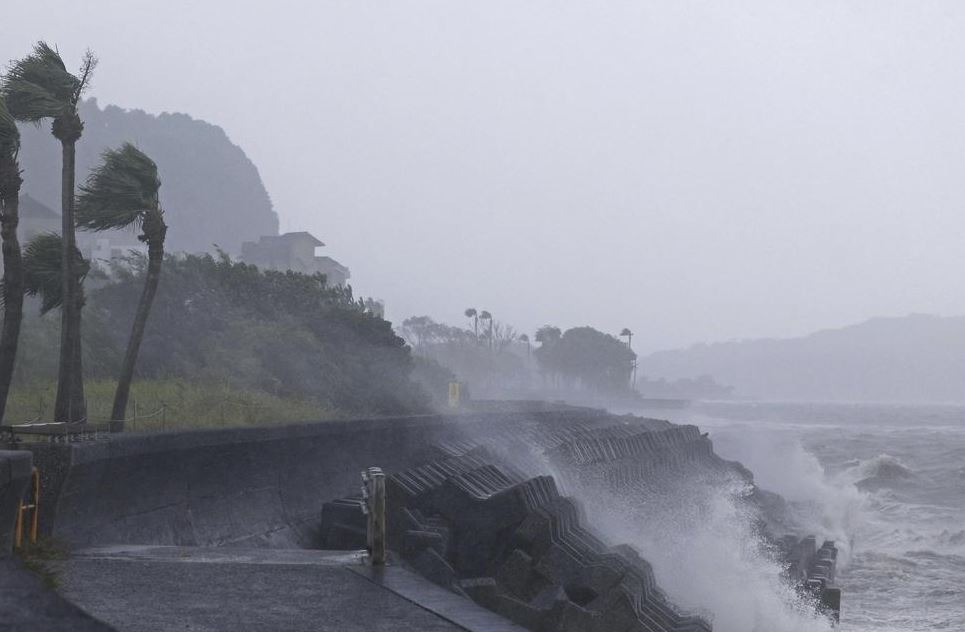Japan is on high alert as Typhoon Shanshan, a formidable storm characterized by its potent winds and heavy rains, edges closer to the nation’s southwestern regions. With a slow-moving trajectory akin to a bicycle’s pace, the typhoon is causing significant disruptions to transportation and delivery services across the country. The Japan Meteorological Agency (JMA) has issued stern warnings as the storm threatens to impact daily life significantly.
Current Situation and Meteorological Insights
As of Wednesday, August 28, 2024, Typhoon Shanshan was approximately 120 kilometers (75 miles) south of Yakushima Island, a southern outpost of Japan, with its sights set on Kyushu. The storm boasts winds reaching up to 180 kilometers per hour (112 miles per hour), making it a severe weather event with the potential for widespread damage. According to the JMA, Shanshan is expected to make landfall in southern Kyushu on Thursday, August 29, 2024.
The JMA’s forecast indicates that the typhoon will bring torrential rainfall, with predictions suggesting up to 600 millimeters (23.6 inches) in some areas of southern Kyushu over a 24-hour period. This deluge could lead to severe flooding and landslides, particularly in regions already vulnerable to such natural disasters.
Impact on Transportation and Public Services
The impending arrival of Typhoon Shanshan has triggered a series of preemptive measures affecting transportation and public services. Numerous domestic flights connecting southwestern cities and islands have been canceled through Friday, with disruptions expected to continue if the storm’s intensity persists. Japan Railway companies have also announced that most bullet trains and local train services will be halted in Kyushu starting Thursday, with possible extensions of these cancellations to the main island of Honshu through the weekend.
Postal and delivery services in the Kyushu region have been suspended, causing potential delays in mail and package deliveries. Additionally, supermarkets and other retail establishments in the affected areas have announced early closures to ensure the safety of both staff and customers. The typhoon’s impact on these essential services underscores the significant disruptions caused by such severe weather events.
Government Response and Public Advisory
In response to the imminent threat, Japan’s Disaster Management Minister, Yoshifumi Matsumura, convened a task force meeting to address the situation. During the meeting, Mr. Matsumura emphasized the importance of early precautionary measures, urging residents in Shanshan’s projected path to seek shelter and prepare for possible evacuations. He specifically highlighted the need for elderly residents and those with special needs to take proactive steps to ensure their safety.
In light of the ongoing threat, the Japanese government has decided to cancel its annual earthquake drills scheduled for Sunday. This decision aims to allocate resources more effectively towards disaster response efforts related to the typhoon. While no reports of damage or injuries have emerged as of yet, the situation remains fluid, with the potential for significant impacts as Shanshan progresses.
Historical Context and Preparedness
Japan, a country frequently subjected to typhoons and other natural disasters due to its geographical location, has developed extensive protocols for handling such emergencies. The country’s preparedness measures include regular drills, comprehensive early warning systems, and robust infrastructure designed to mitigate the effects of severe weather. Nevertheless, each typhoon presents unique challenges, and the response to Typhoon Shanshan illustrates the ongoing need for vigilance and adaptability.
Historically, Japan has faced various devastating typhoons that have caused extensive damage and loss of life. The response to Typhoon Shanshan highlights both the improvements in disaster management over time and the continuous need for community preparedness and resilience in the face of natural hazards.
Community and Individual Actions
In addition to government-led efforts, individual and community actions play a crucial role in managing the impact of Typhoon Shanshan. Residents are advised to secure their homes, prepare emergency kits with essential supplies, and stay informed through reliable news sources and official channels. Local community groups and organizations often provide additional support and resources, such as temporary shelters and emergency assistance.
The importance of community cohesion and preparedness cannot be overstated. By working together and following official guidance, communities can better navigate the challenges posed by severe weather events and enhance their overall resilience.
Future Outlook
As Typhoon Shanshan continues its approach, the situation will likely evolve, with potential adjustments to forecasts and response measures. The JMA and other relevant authorities will provide updated information and guidance as needed. It is essential for residents and businesses in the affected areas to remain attentive to official communications and adhere to safety recommendations.
The aftermath of Typhoon Shanshan will also bring opportunities to assess the effectiveness of current disaster response strategies and identify areas for improvement. Continuous evaluation and adaptation are vital for enhancing preparedness and resilience against future natural disasters.
Conclusion
Typhoon Shanshan represents a significant challenge for Japan, with its potential to cause widespread disruptions and impact public services. The government’s proactive measures and public advisories underscore the seriousness of the situation and the need for collective effort in managing the storm’s effects. As the typhoon progresses, staying informed and prepared will be crucial for ensuring safety and minimizing damage. Japan’s response to Typhoon Shanshan exemplifies the nation’s commitment to managing natural disasters effectively and its ongoing efforts to safeguard its citizens in the face of severe weather challenges.
Soumya Smruti Sahoo is a seasoned journalist with extensive experience in both international and Indian news writing. With a sharp analytical mind and a dedication to uncovering the truth, Soumya has built a reputation for delivering in-depth, well-researched articles that provide readers with a clear understanding of complex global and domestic issues. Her work reflects a deep commitment to journalistic integrity, making her a trusted source for accurate and insightful news coverage.



